- 10 Minutes to read
- Print
- DarkLight
- PDF
June 19 Release Notes
- 10 Minutes to read
- Print
- DarkLight
- PDF
Enhancements to Application Behavior
This section provides you with a quick overview of features and functionality delivered with this release that may affect the way you use the Host Analytics application. It is not a comprehensive list of all the features delivered with this release; but rather those features that impact the way in which the application behaves.
Data Load Rules
The first 100 records from NetSuite Saved Search is fetched and now displayed in the Raw Data pane.
Planning: Personalize the Employees list page
With this release, you can now personalize the Employees list page for the Detailed HR template by using the Settings option. Columns can be rearranged or hidden as per your requirement and then saved as your default view. You can also view two columns side-by-side and hide all the columns between these two columns. In addition, this customized list can be exported. Admin users can initially set the order, which can be further personalized by users.
In Practice: How to Personalize the Employee list page (End users)
End users can personalize the Employee list page by following these steps:
From the Planning Control Panel, open an HR template.
On the Employees list page, click the Settings icon. All the column check boxes are selected by default.
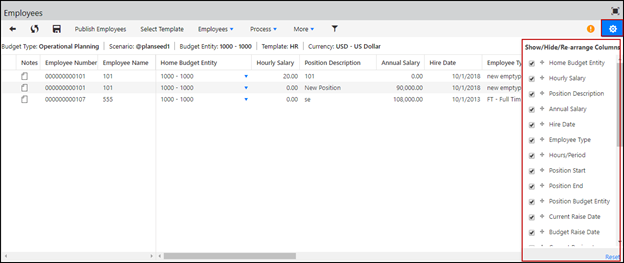
Unselect the column that you want to hide, and the changes are auto-saved.
To arrange the columns in a certain order, click the drag indicator and drag the column next to the required column.
You can also move the columns on the Employee list page in the required order.
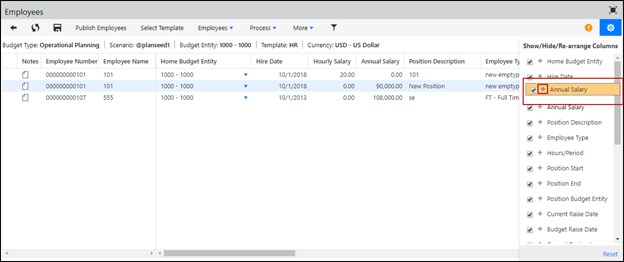 The changes are auto-saved, and this is your default view for the scenario. To export the data in the order that is visible on the screen, click More and then select Export as Excel.
The changes are auto-saved, and this is your default view for the scenario. To export the data in the order that is visible on the screen, click More and then select Export as Excel.To reset the columns to the default arrangement of your Administrator, click Reset.
In Practice: How to Personalize the Employee list page (Admin users)
Access the Employee list page by navigating to Maintenance > Admin > Detailed HR.
In the Employees section, click the Settings icon. All the column check boxes are selected by default.
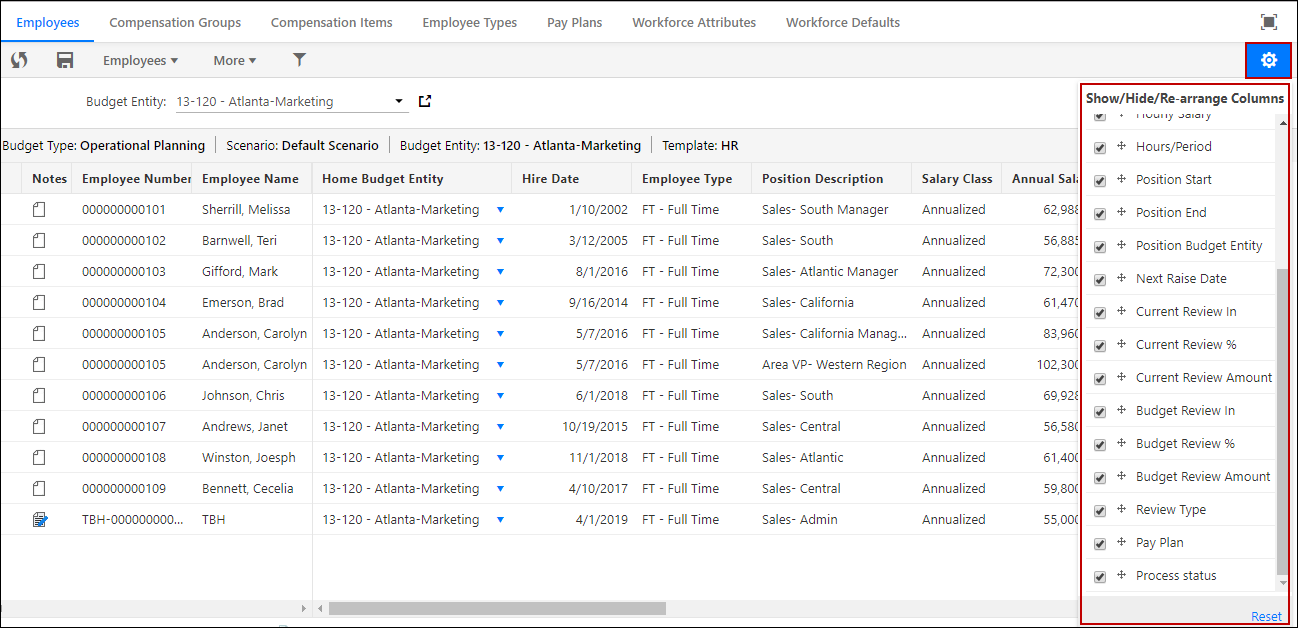
Unselect the column that you want to hide, and the changes are auto-saved.
To arrange the columns in a certain order, click the drag indicator and drag the column next to the required column.
You can also move the columns on the Employee list page in the required order.
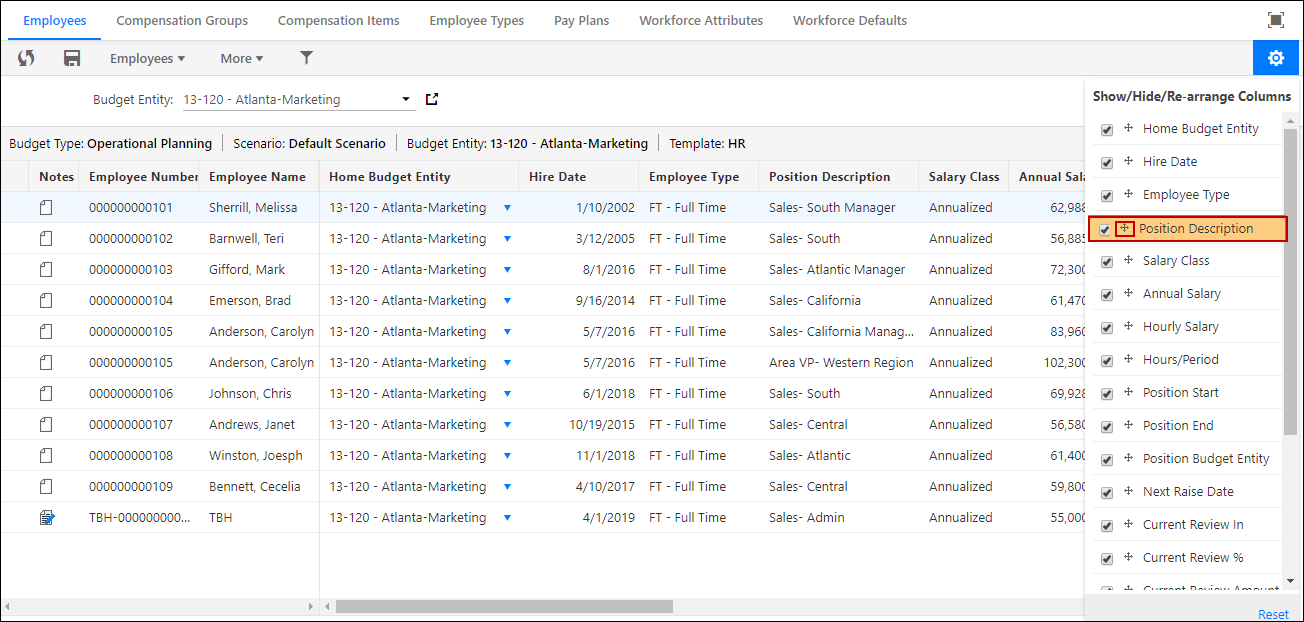 The changes are auto-saved, and this is your default view for the scenario. To export the data in the order that is visible on the screen, click More and then select Export as Excel.
The changes are auto-saved, and this is your default view for the scenario. To export the data in the order that is visible on the screen, click More and then select Export as Excel.To reset the columns to the default arrangement available in the application, click Reset.
Reporting: Reporting Dimension Custom Labels Displayed in Direct Connect Models
Custom labels created for Reporting dimension members and rollups are now shown in Modeling reports for Direct Connect models. This ensures consistency in member labels across modules.
With Custom Label functionality, a value can be set for rollup members on the Reporting dimension, consolidated common currency, and consolidated local currency. Once the value is set, the Reporting dimension must be processed so that the updated values are applied in reports. Additionally, the Direct Connect model must be refreshed so that the updated values are applied.
See Also: Connecting to a Direct Connect Model and Refreshing a Direct Connect Model
Reporting: Report Security Usability
Contact Host Analytics Support to enable this feature in your Production environment.
With this release, we have enhanced the interface for Report Security by redesigning the functionality for better user experience. A Share option has been added to the More list box in the File Cabinet page. Additionally, the Bulk Action list box and Export to Excel drop-down list has been added to the Report Access page.
Share Option in the More List Box
The Share option allows you to provide users and user groups with access to reports and reporting artifacts.
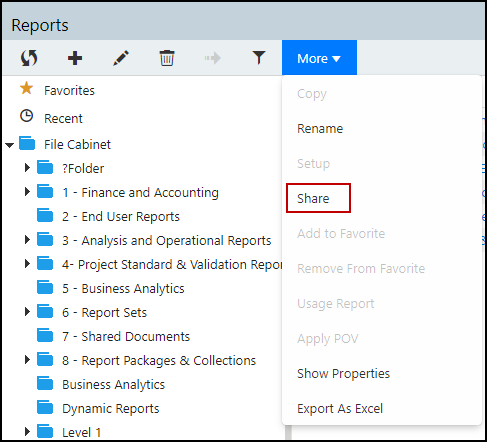
In Practice: Share the report security access
To share the report security access with a user or user group follow these steps:
- Go to File Cabinet > select a report or folder > More list box > Share. The Share pop-up window is displayed as shown in the image below.
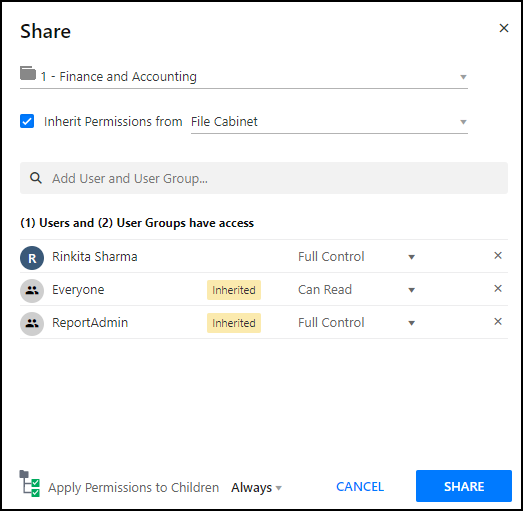
- Select the required folder or report from the drop-down list. By default, the folder or report selected in the File Cabinet page is displayed in the drop-down list.
- Select the Inherit Permissions from checkbox and then select the required folder from which you wish to inherit permissions. Permissions can be inherited only from one of the parent folders in the hierarchy.
- In the search box, type the user or user group name that you want to add.
- Select any of the following access privilege:
Can Read
Can Edit
Full Control
Note:You can provide Can Edit access only to folders.
- Select one of the following from the Apply Permissions to Childrendrop-down list:Note:The Apply Permissions to Children drop-down list is only visible for folders.
Always -If selected, the source artifact permissions are inherited to existing and newly added artifacts at all levels. The artifact status is displayed as Inherited beside the user or user group name.
For example, if Always is selected for a parent artifact, then the children artifacts will inherit the same permissions as the parent. The image below displays that the Consolidation Reports (child) folder inherits the same permissions as the Finance and Accounting (parent) folder.
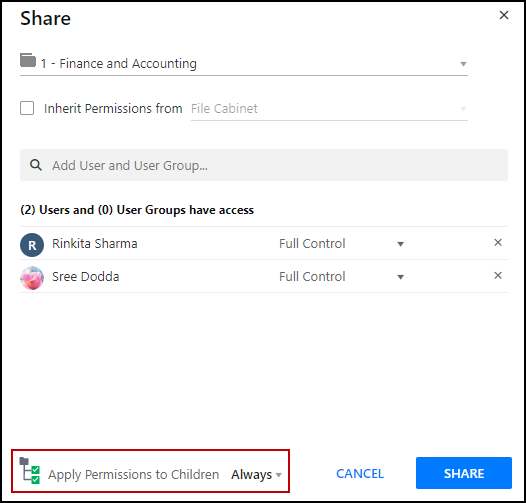
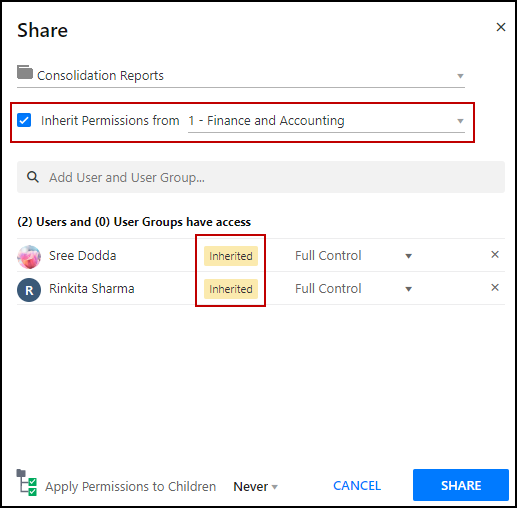
- When the permissions on the source artifact is updated, the same permissions are applied to all its children automatically.
Note:The permissions for a user or user group is not updated if you override or remove the permission in the target artifact.
Permissions are updated or removed only for a user or user group who have the status as Inherited or when a new user or user group is added to the source artifact.- Once - If selected, the artifact permissions are copied only to all the existing children. Any new child added to the artifact will not have the same permissions. Also, if you update permissions on the source artifact, the same permissions are not copied to its children automatically.
- Never - If selected, the artifacts have independent permissions. By default, this option is selected.
Report Security Export
With this release, you can export the Report Security details. The report contains information about a user’s access details.
The Export to Excel drop-down list has been added to the Report Access page. Now, you can select any of the following options and export the Report Security details:
Export All Users: Exports the Report Security details of all the users.
Export Selected User: Exports the Report Security details of a user selected from the Report Access page.

In Practice
You can generate the Report Security details by navigating to Maintenance > User Management > User> More> Report Access > Export to Excel.
If you select the Export Selected User option, then Report Security Export is downloaded directly to your system. When you select the Export All Users option, a notification is displayed that Report Security Export has been submitted for processing. After the process is complete, a link to download the report is displayed. You can either click the link to download or you can view the report sent to your registered e-mail address.
Bulk Action in Report Access
With this release, you have the ability to perform bulk actions in the Report Access page. A Bulk Actions list box has been introduced in the Report Access page. Any user with access to User Management can update Report Access for a user or user group or artifact. You can perform the following actions in the Report Access page:
Add Permissions - Allows you to provide permissions to multiple artifacts available in the File Cabinet. By default, Full Control access is enabled to the artifacts that are assigned to a user or user group. Reporting Administrators have access to all artifacts.
Edit Permissions - Allows you to select multiple artifacts assigned to a user or user group and update their permissions. Can Edit access is not applicable to a few artifacts. If you assign Can Edit access to these artifacts, then Can Read access is assigned to users by default.
Remove Permissions - Allows you to select multiple artifacts assigned to a user or user group and remove their permissions. If access to a folder is removed, then access to any subfolders and artifacts under the folder are automatically removed.

Modeling 2.9.1: New Add-In
This add-in includes fixes to existing known issues. Please upgrade your existing client software. See Where to Download SpotlightXL and Version Information for information.
Platform: Ability to Perform Data Manipulations on a NetSuite Connect Data Load Rule
With this release, the Data Manipulations functionality is now available when you load data using a NetSuite Connect Data Load Rule. The Data Manipulations functionality allows you to change the way data is loaded from your source solution to Host Analytics (target). You can perform the following actions using this functionality:
Add new column
Duplicate existing column
Edit Headers Name
Join Data
Split Data
Replace
Show Column Header
Manage Manipulations
You can manipulate the data displayed in the Raw Data pane during the Manipulate Input File step of the Data Load Rule process as shown in the image below. The manipulated data is displayed in the Manipulated Data pane.
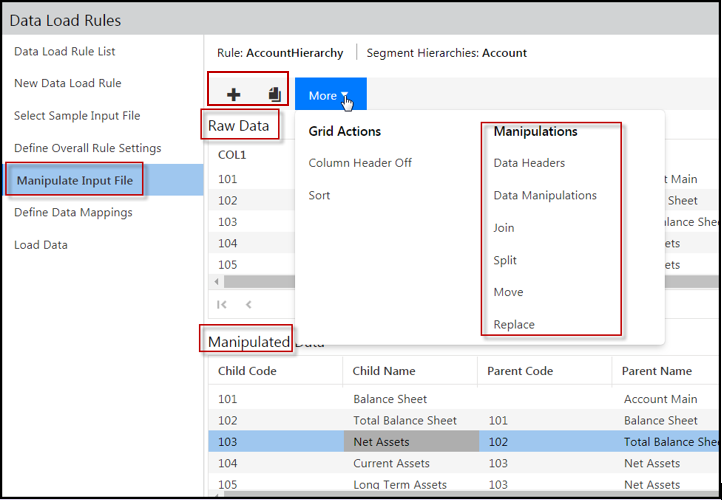
In Practice
- Navigate to Maintenance > DLR > Data Load Rules.
- Click the New tab.
- Enter a name for the DLR.Data Load Rule
For Load Type, select NetSuite Connect as shown below.:
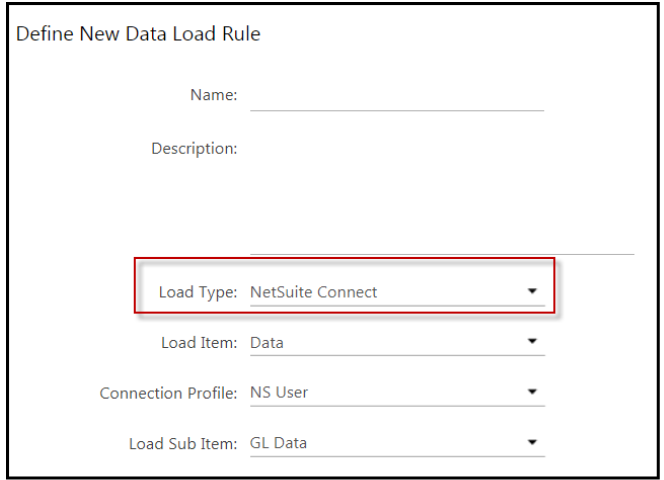
- From the Load Item drop-down list, select the required load item. Segment Hierarchies, Currency Exchange Rates, GL Data, and Transaction Data are load type items supported by the application.
- For Connection Profile, select the name of the profile configured. For information on how to configure a Connection Profile, click here.
- From the Load Sub Item drop-down list, select an item and click Next.
- Row with Header and # of Rows to Skip must be left as 0. Specify the # of Source Fields with the number of columns to be mapped in the Define Data Mappings step from the NetSuite Saved Search.
Select the NetSuite Saved Search in the Select Sample Input File step. For information on NetSuite Saved Search, click here.
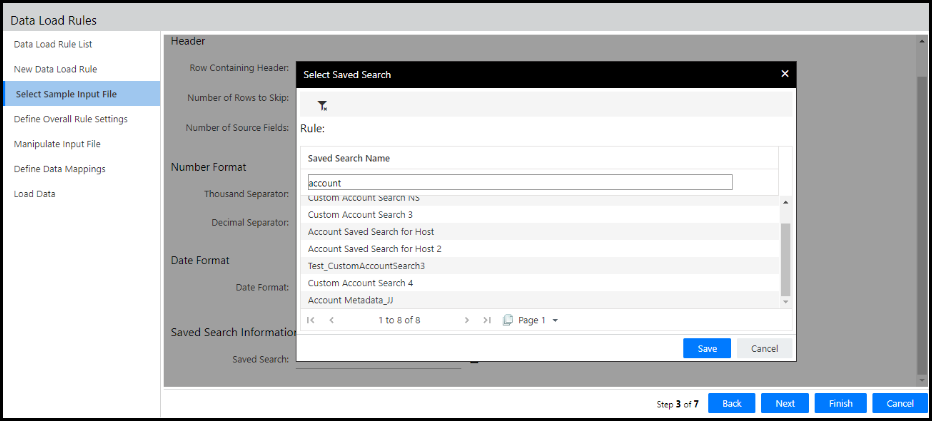
In the Manipulate Input File step, the first 100 records from NetSuite Saved Search is fetched and displayed in the Raw Data pane. Prior to this release, the data was not displayed in the Manipulate Input File step.
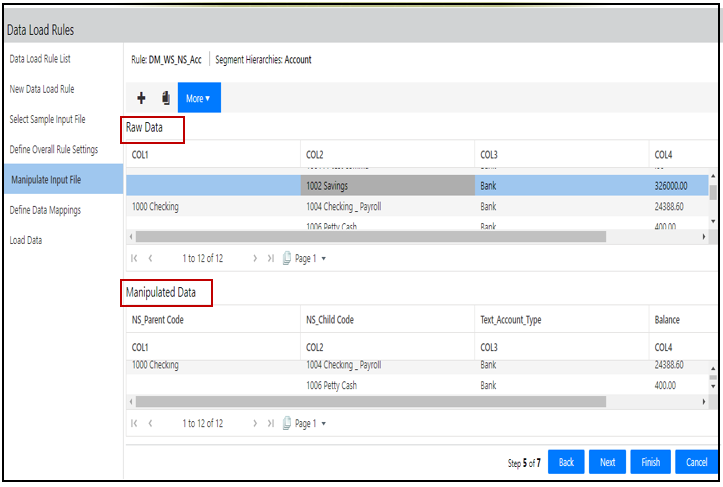 Note:You have to perform all the remaining steps to successfully complete the DLR creation process.
Note:You have to perform all the remaining steps to successfully complete the DLR creation process.You have to perform additional actions to set up NetSuite Connect before using it. For more information about NetSuite Connect and its setup procedure, click here.
Workaround for Existing DLR
The Data Manipulations functionality is applicable only to the NetSuite Connect DLR’s that are created after June 2019 Release and in the RESTlet mode.
For customers using the RESTlet mode prior to June 2019 Release or for customers who migrated to RESTlet mode from the Web Services mode, the workaround steps to enable the Data Manipulations functionality are as follows:
- From the Load Type drop-down list, select any load type other than NetSuite Connect. For more information, see the Data Integration Admin Guide.
- From the Load Type drop-down list, select NetSuite Connect.
When you navigate to the Manipulate Input File page, you can now view the raw data and can perform the required Data Manipulations.
When you navigate to the Define Data Mappings page, you can view columns from NetSuite under the Source Column field.
Platform: Enhancement in Define Data Mappings
With this release, columns from NetSuite are displayed under the Source Column field in the Define Data Mappings page. The number of source columns is based on the value of # of Source fields in the Select Sample Input File step.
Prior to this release, the source and target columns were drop-down list on the Define Data Mappings page.
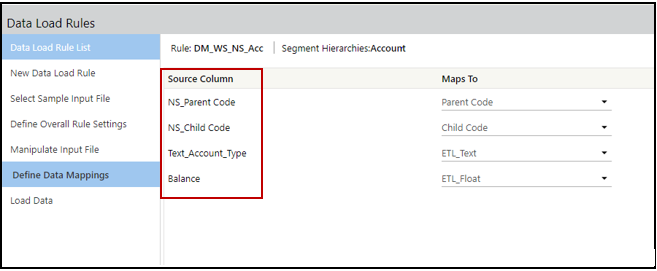
Best Practice
Navigate to the Manipulate Input File step prior to the Define Data Mappings step to fetch the latest column header information and to preview the saved search data.
When the Process Flow is running, you should not navigate to the Manipulate Input File page of the DLR used in the Process flow.

